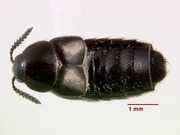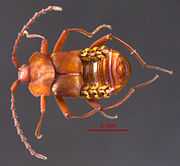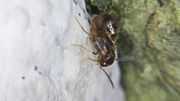Aleocharinae
| Aleocharinae | |
|---|---|
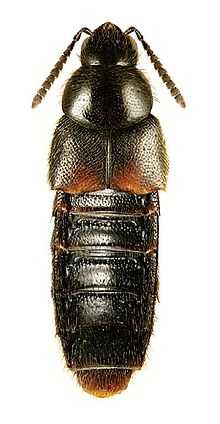 | |
| Aleochara lanuginosa | |
| Scientific classification | |
| Kingdom: | Animalia |
| Phylum: | Arthropoda |
| Class: | Insecta |
| Order: | Coleoptera |
| Suborder: | Polyphaga |
| Infraorder: | Staphyliniformia |
| Superfamily: | Staphylinoidea |
| Family: | Staphylinidae |
| Subfamily: | Aleocharinae Fleming, 1821 |
| Synonyms | |
| |
Aleocharinae is one of the largest subfamilies of rove beetle, containing over 12,000 species. Previosly subject to large-scale debate whether the subfamily deserved the familial status, it is now considered one of the largest subfamilies of rove beetle. [2] [3]
Description
Aleocharinae are generally small to minute beetles, as they can reach a maximum length of about 10 millimetres (0.39 in), but usually the are 3–5 millimetres (0.12–0.20 in) long, with a few species of 1 millimetre (0.039 in), among the smallest of beetles. The body is usually slender, often densely and finely punctured, the head is more or less round and the color may be light or dark brown, reddish-brown or black, sometimes with contrasting colors of red, yellow and black. [3]
Anatomy
Because of the largeness of the subfamily, the anatomy of the subfamily is extremely variable. However, there are a few key features all rove beetles of the subfamily share. All members have antennae that have 10 or 11 segments. The antennal insertion is posterior to a line drawn between the anterior margins of the eyes or anterior to a line drawn between the anterior margins of the eyes. The tarsal segments vary from 2-2-2 to 4-5-5.
Distribution and habitat
Rove beetles belonging to this subfamily are distributed throughout the world in almost all terrestrial habitats. They are commonly predators in soil communities and leaf litter, frequently inquilines in ant and termite nests or associated with mushrooms and fungi. [3]
Ecology
This subfamily is common on all terrestrial habitats. It is collected through several methods, including the use of UV light, emergence chambers, sifting, using Berlese organic material and pitfall traps.
The biology of the subfamily is complex. Many species are highly specialized, and thus are prone to extinction. There are free living, parasitic, herbivore, carnivore, fungivore, flier, walker, runner, swimmer, social and solitary forms, but the life history is almost unknown at the species level.
Systematics
This subfamily is one of the largest rove beetle subfamilies, containing 52 tribes, over 1000 genera, and over 12000 described species (about 1385 known from North America). This subfamily is a taxonomically difficult groups of beetles.It is very unknown and is in need of more studying from scientists. [3]
Tribes and selected genera
Below is a list of all the tribes and some selected genera. [4] [3]
- Tribe Aleocharini Fleming, 1821
- Aleochara Gravenhorst, 1802
- Tinotus Sharp, 1883
- Tribe Athetini Casey, 1910
- Acrotona Thomson, 1859
- Actophylla Bernhauer, 1908
- Alevonota Thomson, 1856
- Alianta Thomson, 1858
- Aloconota Thomson, 1858
- Amischa Thomson, 1858
- Anopleta Mulsant & Rey, 1874
- Atheta Thomson, 1858
- Brundinia Tottenham, 1949
- Cadaverota Yosii & Sawada, 1976
- Callicerus Gravenhorst, 1802
- Coprothassa Thomson, 1859
- Dacrila Mulsant & Rey, 1874
- Dadobia Thomson, 1856
- Dilacra Thomson, 1858
- Dinaraea Thomson, 1858
- Disopora Thomson, 1859
- Dochmonota Thomson, 1859
- Geostiba Thomson, 1858
- Halobrecta Thomson, 1858
- Hydrosmecta Thomson, 1858
- Liogluta Thomson, 1858
- Lundbergia Muona, 1975
- Lyprocorrhe Thomson, 1859
- Nehemitropia Lohse, 1971
- Ousipalia Des Gozis, 1886
- Pachnida Mulsant & Rey, 1874
- Pachyatheta Munster, 1930
- Paranopleta Brundin, 1954
- Philhygra Mulsant & Rey, 1873
- Pycnota Mulsant & Rey, 1874
- Schistoglossa Kraatz, 1856
- Thamiaraea Thomson, 1858
- Tomoglossa Kraatz, 1856
- Trichiusa Casey, 1856
- Trichomicra Brundin, 1941
- Tribe Autaliini Thomson, 1859
- Autalia Samouelle, 1819
- Tribe Corotocini Fenyes, 1918
- Abrotelina
- Corotocina
- Coatonachthodes Kistner, 1968
- Eburniogastrina
- Nasutitellina
- Sphuridaethina
- Termitocharina
- Termitocupidina
- Termitogastrina
- Termitoiceina
- Termitopithina
- Termitoptochina
- Timeparthenina
- Incertae Sedis
- Tribe Deinopsini Sharp, 1883
- Deinopsis Matthews, 1838
- Tribe Diglottini Jacobson, 1909
- Diglotta Champion, 1887
- Tribe Dorylogastrini Wasmann 1916
- Berghoffia
- Dorylocratus
- Dorylogaster
- Tribe Dorylomimini Wasmann 1916
- Dorylomimus
- Dorylonannus
- Jeanneliusa
- Tribe Ecitocharini[5]
- Ecitodaemon
- Ecitomorpha
- Ecitophya
- Ecitoschneirla
- Ecitosymbia (=Ecitoxenides)
- Ecitoxenia
- Ecitoxenides
- Retteneciton
- Seeverseciton
- Tribe Ecitogastrini
- Ecitogaster
- Tribe Falagriini Mulsant & Rey, 1873
- Anaulacaspis Ganglbauer, 1895
- Borboropora Kraatz, 1862
- Cordalia Jacobs, 1925
- Falagria Samouelle, 1819
- Falagrioma Casey, 1906
- Flavipennis Cameron, 1920
- Myrmecocephalus MacLeay, 1871
- Myrmecopora Saulcy, 1865
- Tribe Homalotini Heer, 1839
- Subtribe Gyrophaenina Kraatz, 1856
- Agaricochara Kraatz, 1856
- Encephalus Kirby, 1832
- Gyrophaena Mannerheim, 1830
- Subtribe Bolitocharina Thomson, 1859
- Bolitochara Mannerheim, 1830
- Euryusa Erichson, 1837
- Heterota Mulsant & Rey, 1874
- Leptusa Kraatz, 1856
- Phymatura J. Sahlberg, 1876
- Tachyusida Mulsant & Rey, 1872
- Subtribe Silusina Fenyes, 1918
- Silusa Erichson, 1837
- Subtribe Homalotina Heer, 1839
- Anomognathus Solier, 1849
- Homalota Mannerheim, 1830
- Pseudomicrodota Machulka, 1935
- Thecturota Casey, 1893
- Subtribe Rhopalocerina Reitter, 1909
- Clavigera Scriba, 1859
- Cyphea Fauvel, 1863
- Subtribe Gyrophaenina Kraatz, 1856
- Tribe Hygronomini Thomson, 1859
- Hygronoma Erichson, 1837
- Tribe Hypocyphtini Laporte de Castelnau, 1835 (= Oligotini Thomson, 1859)
- Cypha Samouelle, 1819
- Holobus Solier, 1849
- Oligota Mannerheim, 1830
- Tribe Lomechusini Fleming, 1821 (= Myrmedoniini Thomson, 1867)
- Drusilla Samouelle, 1819
- Lomechusa Gravenhorst, 1806
- Lomechusoides Tottenham, 1939 (Lomechusoides strumosus)
- Maschwitzia
- Meronera
- Myrmedonota
- Zyras Stephens, 1835
- Tribe Myllaenini Ganglbauer, 1895
- Myllaena Erichson, 1837
- Tribe Oxypodini Thomson, 1859
- Subtribe Oxypodina Thomson, 1859
- Acrostiba Thomson, 1858
- Amarochara Thomson, 1858
- Calodera Mannerheim, 1830
- Cephalocousya Lohse, 1971
- Chanoma Blackwelder, 1952
- Chilomorpha Krasa, 1914
- Crataraea Thomson, 1858
- Drusilla Blackwelder, 1952
- Dexiogya Thomson, 1858
- Haploglossa Kraatz, 1856
- Hygropora Kraatz, 1856
- Ilyobates Kraatz, 1856
- Ischnoglossa Kraatz, 1856
- Mniusa Mulsant & Rey, 1875
- Ocalea Erichson, 1837
- Ocyusa Kraatz, 1856
- Oxypoda Mannerheim, 1830
- Parocyusa Bernhauer, 1902
- Pentanota Bernhauer, 1905
- Phloeopora Erichson, 1837
- Polylobus
- Poromniusa Ganglbauer, 1895
- Pyroglossa Bernhauer, 1901
- Stichoglossa Fairmaire & Laboulbene,1856
- Thiasophila Kraatz, 1856 (Thiasophila angulata)
- Subtribe Dinardina Mulsant & Rey, 1873
- Dinarda Samouelle, 1819
- Subtribe Meoticina Seevers, 1978
- Meotica Mulsant & Rey, 1873
- Subtribe Tachyusina Thomson, 1859
- Brachyusa Mulsant & Rey, 1874
- Dasygnypeta Lohse, 1974
- Gnypeta Thomson, 1858
- Ischnopoda Stephens, 1835
- Subtribe Oxypodina Thomson, 1859
- Tribe Phytosini Thomson, 1867
- Arena Fauvel, 1862
- Phytosus Curtis, 1838
- Tribe Placusini Mulsant & Rey, 1871
- Placusa Erichson, 1837
- Tribe Tachyusini
- Tribe Termitodiscini
- Termitodiscus
- Termitogerrus
- Tribe Termitohospitini
- Coptotermocola
- Neotermitosocius
- Termitobra
- Termitohospes
- Termitosocius
- Termitosodalis
- Tribe Termitonannini
- Tribe Termitopaediini [6]
- Coatonipulex Kistner, 1977
- Dioxeuta negaricus
- Macrotermophila pretoriusi
- Macrotoxenus sumatrensis
- Paratermitopulex Kistner, 1977
- Physomilitaris Kistner, 1977
- Polyteinia
- Protermitobia thoracotoxenus
- Termitobia darlingtonae
- Termitolinus blandus
- Termitonda
- Termitopaedia bilineatus
- Termitopulex darlingtonae
- Termitotecna angolensis
- Termitotropha rufobrunneus
- Termozyras
- Tribe Termitusini
- Termitana
- Termitoecia
- Termitospectrum
- Termitusa
- Termitusodes
- Tribe Trichopseniini LeConte & Horn 1883
- Tribe Trilobitideini
- Trilobitideus
Gallery
-
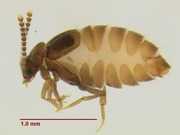
Xenistusa sp.
-
Bolitochara lucida on fungus
-
_genital_(3724331920).jpg)
Male (left) and female genitals of Ischnoglossa prolix
Bibliography
- Ferro, M. L., M. L. Gimmel, K. E. Harms, and C. E. Carlton. 2012a. Comparison of the Coleoptera communities in leaf litter and rotten wood in Great Smoky Mountains National Park, USA. Insecta Mundi 259: 1–58.
- Newton, A. F., Jr., M. K. Thayer, J. S. Ashe, and D. S. Chandler. 2001. 22. Staphylinidae Latreille, 1802. p. 272–418. In: R. H. Arnett, Jr., and M. C. Thomas (eds.). American beetles, Volume 1. CRC Press; Boca Raton, FL. ix + 443 p.
- Ashe, J. S. 2005: Phylogeny of the tachyporine group subfamilies and 'basal' lineages of the Aleocharinae (Coleoptera: Staphylinidae) based on larval and adult characteristics. Systematic entomology, 30: 3-37. doi: 10.1111/j.1365-3113.2004.00258.
- Thomas, J. C. 2009: A preliminary molecular investigation of aleocharine phylogeny (Coleoptera: Staphylinidae). Annals of the Entomological Society of America, 102: 189—195. doi: 10.1603/008.102.0201
References
- ↑ Biolib
- ↑ Newton, A. F., Jr., M. K. Thayer, J. S. Ashe, and D. S. Chandler. 2001. 22. Staphylinidae Latreille, 1802. p. 272–418. In: R. H. Arnett, Jr., and M. C. Thomas (eds.). American beetles, Volume 1. CRC Press; Boca Raton, FL. ix + 443 p.
- ↑ 3.0 3.1 3.2 3.3 3.4 James S. Ashe (1947-2005) Tree of life University of Kansas, Lawrence, Kansas, USA
- ↑ Family-group Names in Coleoptera (Insecta), Page 18
- ↑ Kistner D. H. 1990. Cladistic analysis and taxonomic revision of the ecitophilous tribe Ecitocharini with studies of their behavior and evolution (Coleoptera, Staphylinidae, Aleocharinae). Sociobiology (1990). Volume: 17, Issue: 3, Pages: 333—480
- ↑ Kistner D. H. 1977. Cladistic analysis and taxonomic revision of the termitophilous tribe Termitopaediini (Coleoptera: Staphylinidae) with remarks on their evolution and the behavior of some species. Sociobiology (1977). Volume: 2, Issue: 4, Pages: 297—304
| Wikimedia Commons has media related to Aleocharinae. |
| Wikispecies has information related to: Aleocharinae |
